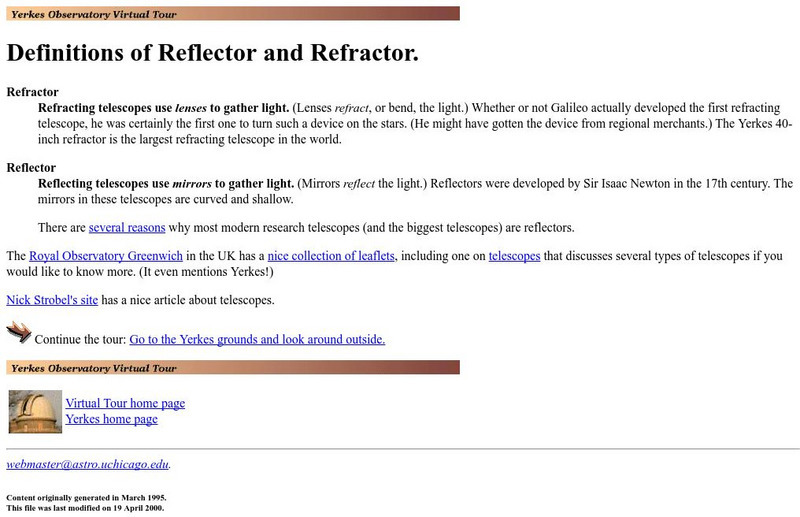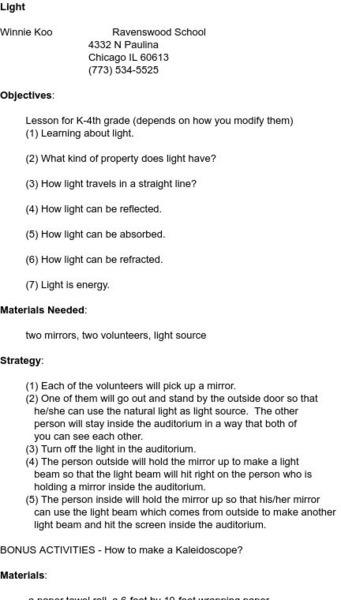Physics Classroom
The Physics Classroom: Image Formation for Concave Mirrors Case A
This animation depicts the path of light to each person's eye. Different people are sighting in different directions; yet each person is sighting at the same image location. In this animation the image location is the intersection point...
Physics Classroom
The Physics Classroom: Ray Diagrams for Concave Mirrors Case B
Ray diagrams are useful tools for determining the location of an image as produced by a concave mirror. Of all the rays which emanate from the top of the object arrow and are incident to the mirror, there are two rays whose behavior at...
Physics Classroom
The Physics Classroom: Ray Diagrams for Concave Mirrors Case D
Ray diagrams are useful tools for determining the location of an image as produced by a concave mirror. Of all the rays which emanate from the top of the object arrow and are incident to the mirror, there are two rays whose behavior at...
Physics Classroom
The Physics Classroom: Lesson 3: Concave Mirrors
Lesson 3 of this tutorial on refraction is on concave mirrors. Content that is covered includes the anatomy of curved mirrors, reflection of light and image formation, ray diagrams, image characteristics for concave mirrors, plus more.
Physics Classroom
The Physics Classroom: Reflection and Mirrors: Optics Bench Interactive
Find out about the physics behind those fun-house mirrors. Students manipulate a virtual optics bench to explore the images formed by mirrors and lenses.
University of New South Wales (Australia)
University of New South Wales: School of Physics: Physclips: Geometrical Optics
Physiclips thoroughly presents geometrical optics concepts like rays, refraction, Snell's law, total internal reflection, dispersion, mirrors, and lenses with animations and film clips.
University of Chicago
University of Chicago: Reflector and Refractor
From the Yerkes Observatory Virtual Tour web site. Compares and contrasts reflecting and refracting telescopes. A link from the page leads to a second page which explains why most modern research telescopes are reflecting telescopes.
Science and Mathematics Initiative for Learning Enhancement (SMILE)
Smile: Light (K 4)
This site provides two activities that students can do in class. One uses mirrors to reflect light beams whole another is making a kaleidescope.
Physics Classroom
The Physics Classroom: Refraction/ray Model of Light: Image Formation Revisited
Students take an in-depth look at the physics behind image formation.
Boston University
Bu: Optics: Geometric Optics
Several short descriptions of demonstrations which illustrate principles of geometric optics (many of which focus upon refraction).
My Science Site
Optics: Energy and Control [Pdf]
A very comprehensive unit including topics such as light and its source, visible sources of light, transparency of objects and much more. Also offers a resource list, blackline masters, and expectation list, expectation summary and a...
ClassFlow
Class Flow: Introduction to Light
[Free Registration/Login Required] This flipchart introduces fifth graders to the science of light. Principles such as transparent, translucent, opaque, reflection, and refraction are covered. Concave and convex mirrors and lenses are...
Other
The Disgustoscope
This is a resource to teach optics, while building a modified kaleidoscope that will provide 3-dimensional images.
Curated OER
Reekos Mad Scientist Lab: Light Refraction
Here are simple instructions for creating a prism using a glass of water, a small mirror, and a piece of paper.






